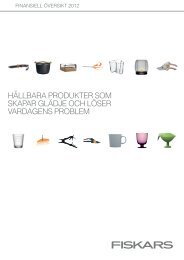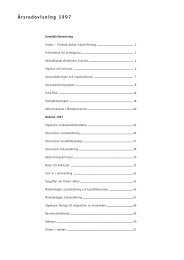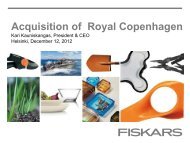FISKARS 1649 â 360 years of Finnish industrial history
FISKARS 1649 â 360 years of Finnish industrial history
FISKARS 1649 â 360 years of Finnish industrial history
You also want an ePaper? Increase the reach of your titles
YUMPU automatically turns print PDFs into web optimized ePapers that Google loves.
Fiskars <strong>1649</strong><br />
Fiskars <strong>1649</strong><br />
Autonomy under Russia 1809–1917<br />
Finland becomes a distinct nation<br />
1789 marked the beginning <strong>of</strong> the French<br />
Revolution. It was followed by Napoleon<br />
Bonaparte’s rise to power in France. The<br />
autocratic King Gustavus III <strong>of</strong> Sweden was<br />
assassinated in 1792 and succeeded by Gustavus<br />
IV Adolphus, who opposed Napoleon’s policies.<br />
In 1808, war broke out again between Russia and<br />
Sweden, with the consequence that in 1809 Finland<br />
was separated from Sweden in the Peace <strong>of</strong> Hamina.<br />
Finland was ceded to the Russian Empire and became<br />
an autonomous Grand Duchy. At the Diet <strong>of</strong> Porvoo<br />
in 1809, Tsar Alexander I granted Finland the status<br />
<strong>of</strong> a distinct nation.<br />
When Finland became part <strong>of</strong> the Russian Empire,<br />
foreign owners <strong>of</strong> land and industry were required<br />
to move to Finland. Bengt Magnus Björkman was<br />
70 <strong>years</strong> old at the time and did not wish to change his<br />
nationality. His eldest son, Bengt Ludvig Björkman,<br />
then in his twenties, was given the task <strong>of</strong> managing<br />
the Fiskars, Antskog and Koski ironworks. When he<br />
moved to Finland, Fiskars became the centre <strong>of</strong> his<br />
ironworks company, and the young owner had new<br />
headquarters built there. In 1812, the national capital<br />
was moved from Turku to Helsinki, and following the<br />
Great Fire <strong>of</strong> Turku in 1827, the national university<br />
also moved to Helsinki. All this was part <strong>of</strong> the Tsar’s<br />
plan to shift the focal point <strong>of</strong> <strong>Finnish</strong> politics and<br />
culture closer to St Petersburg. Politically, Finland was<br />
governed by Russia, but in economy and culture the<br />
country had a wide degree <strong>of</strong> autonomy.<br />
In 1865, Finland acquired its own monetary unit, the <strong>Finnish</strong> mark.<br />
The <strong>Finnish</strong> pavilion at the Paris World Fair in 1900. For the first time Finland<br />
participated as a nation, with its own pavilion.<br />
24<br />
25
















